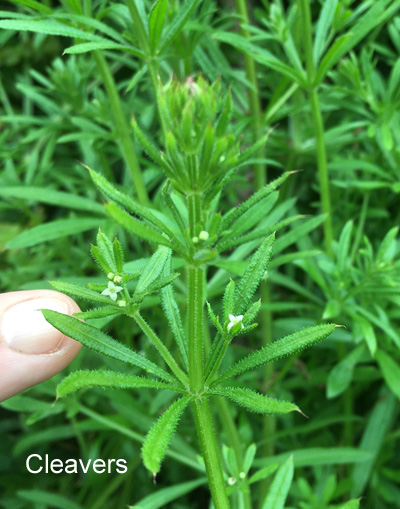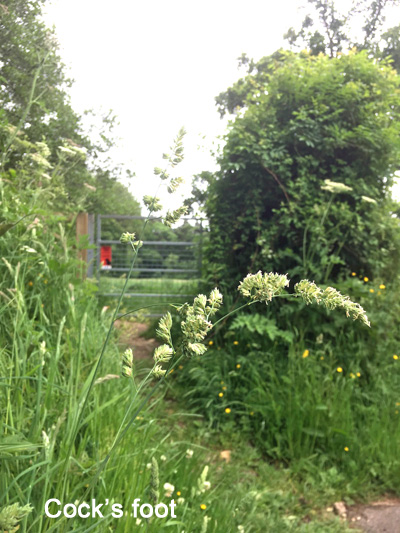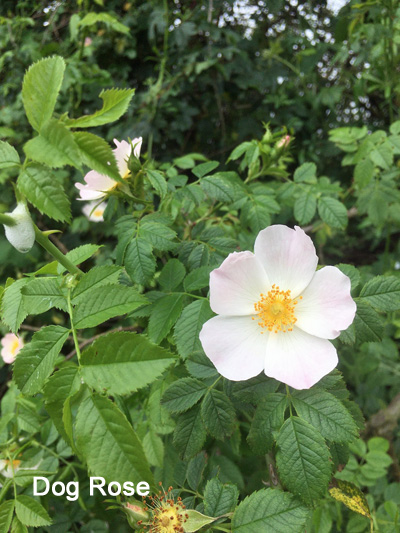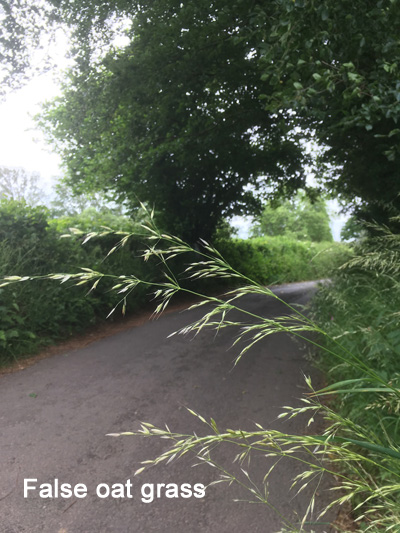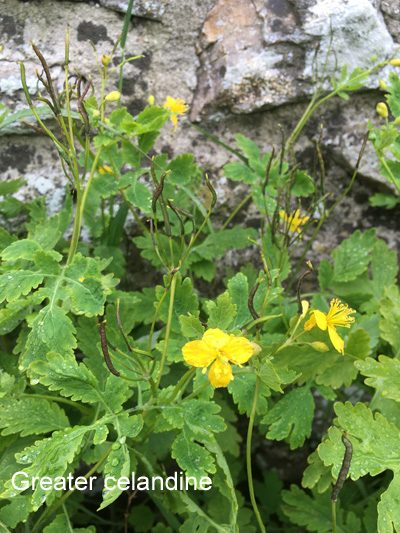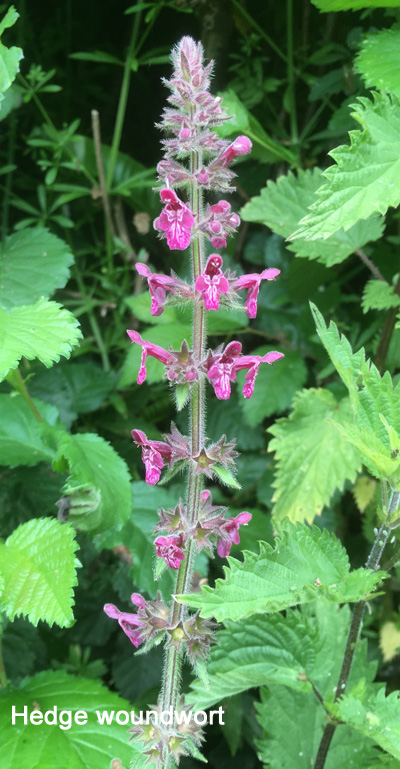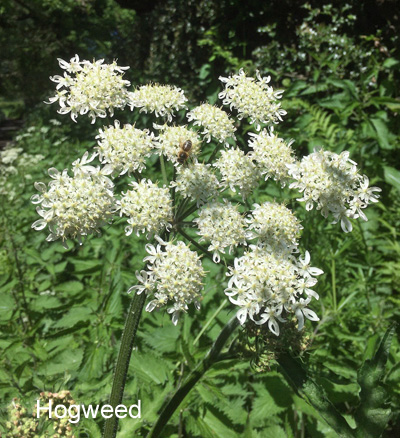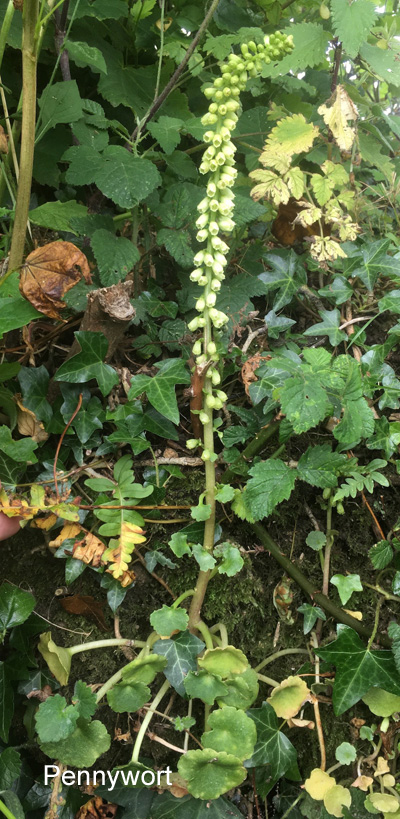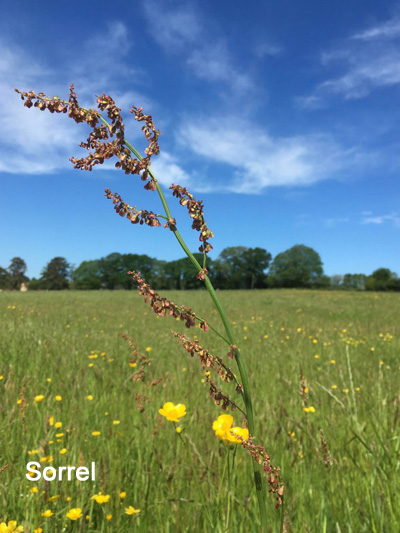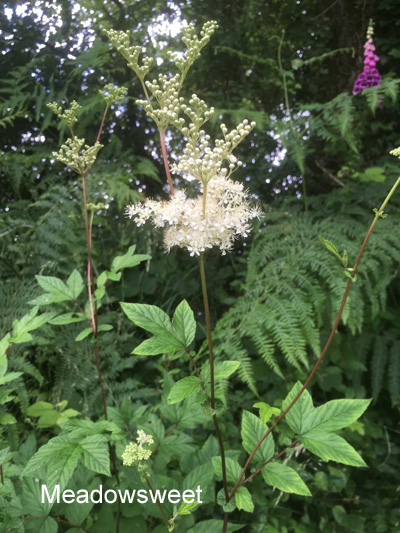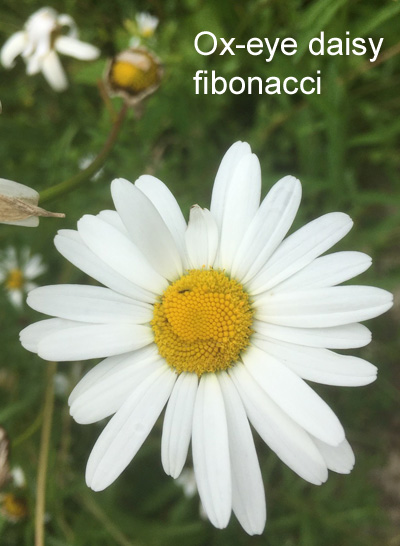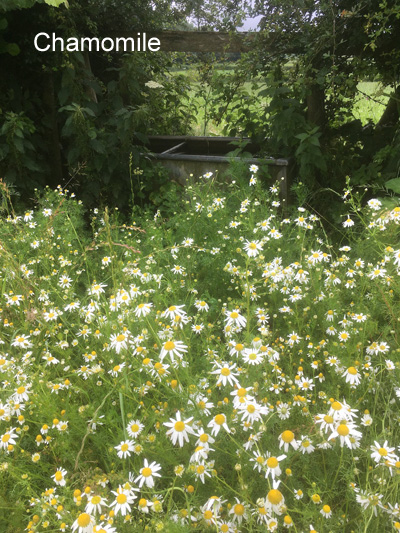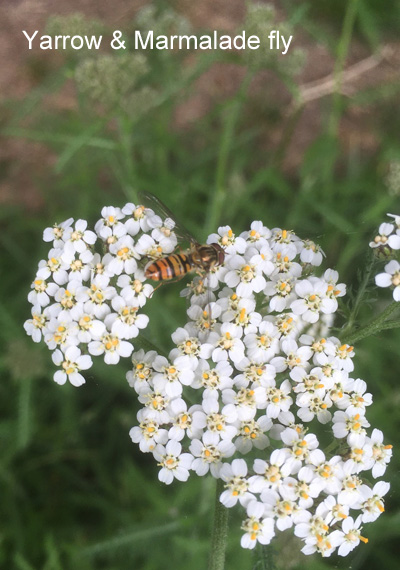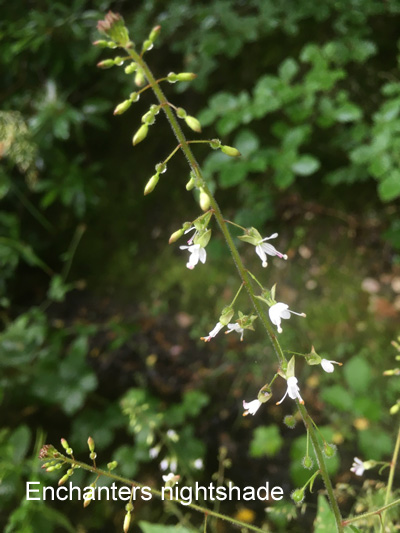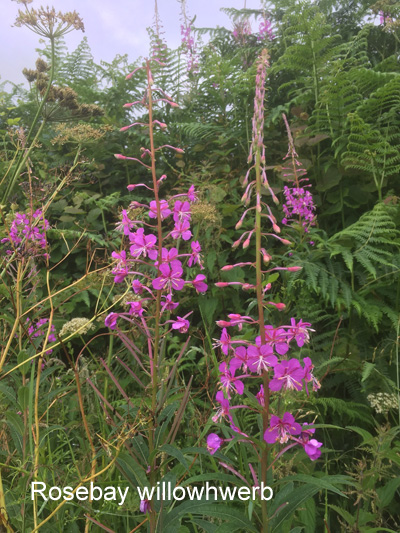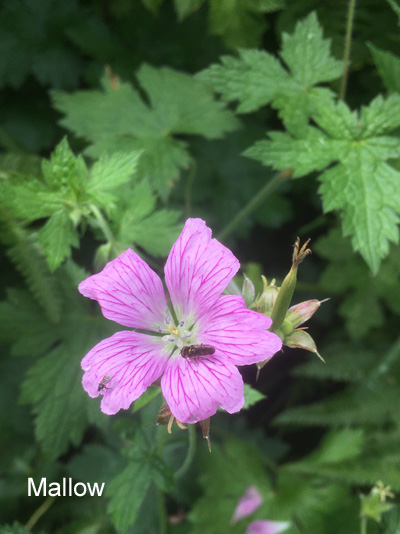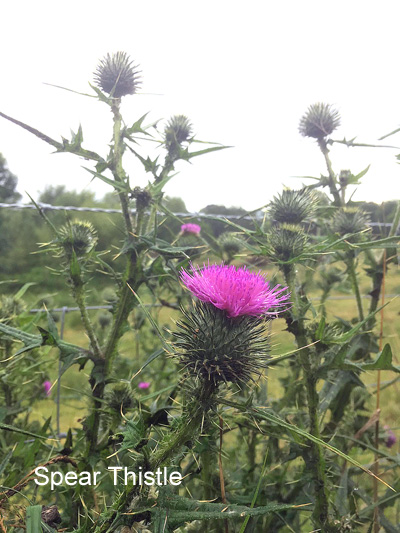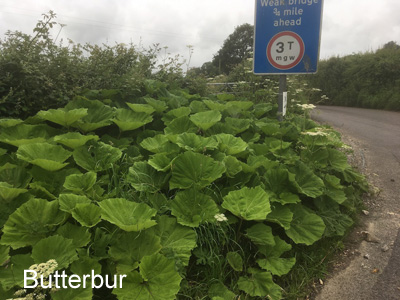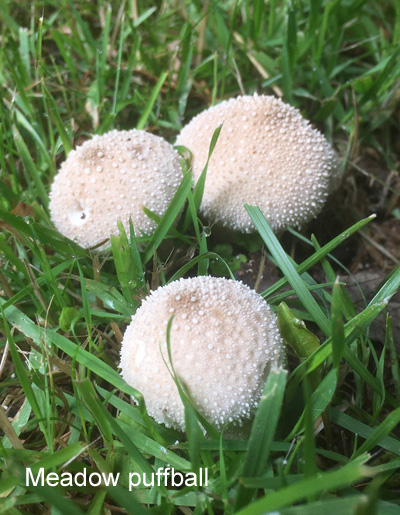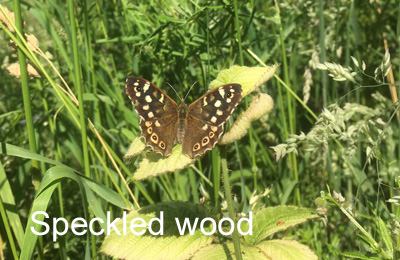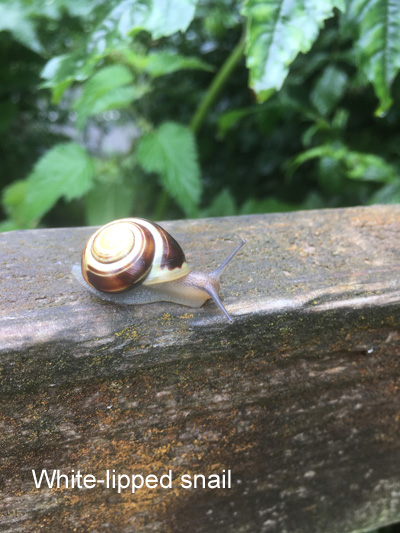March 2021-Early March plants along Winsham
Lanes
It is early M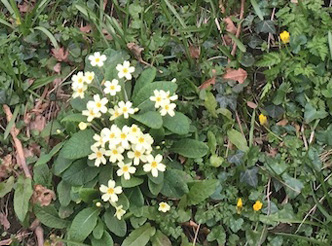 arch, and walking the Winsham lanes the
Snowdrops are going over at last. The yellows are taking over from the
white: stands of Celandine and Primroses,
with
the occasional Dandelion. Because the hedges have been cut or flailed,
more light is reaching the ground, and within the hedgerows the
remaining greens such as Ivy and Holly are joined by newly emerging
plants. Leaves of Lords and Ladies are everywhere; at Whatley and at
Bridge I have seen stands of young Ramsons leaves; here and there on
steep banks the round leaves of Pennywort are a different green from
anything else. And of course ferns stand out at this season, partly
because there are so many of them, partly because there most other
plants are still at a young stage. Hart’s tongue fern can be seen almost
anywhere: it is our only fern with undivided leaves, and those leaves
are long and narrow, and leathery. Despite its name, Common polypody is
less common, though you can find a stand of it in, or on, many a
hedgerow or lane bank. Its leaves are dark green and leathery, and
divided almost to the midrib; the undersides have spores (ferns’ version
of flowers) in round dots along the leaflet midribs. The final fern we
can spot is the Male fern, which has its leaves twice divided, and much
less leathery than the other two. Our commonest fern of all, Bracken, is
still dormant underground. arch, and walking the Winsham lanes the
Snowdrops are going over at last. The yellows are taking over from the
white: stands of Celandine and Primroses,
with
the occasional Dandelion. Because the hedges have been cut or flailed,
more light is reaching the ground, and within the hedgerows the
remaining greens such as Ivy and Holly are joined by newly emerging
plants. Leaves of Lords and Ladies are everywhere; at Whatley and at
Bridge I have seen stands of young Ramsons leaves; here and there on
steep banks the round leaves of Pennywort are a different green from
anything else. And of course ferns stand out at this season, partly
because there are so many of them, partly because there most other
plants are still at a young stage. Hart’s tongue fern can be seen almost
anywhere: it is our only fern with undivided leaves, and those leaves
are long and narrow, and leathery. Despite its name, Common polypody is
less common, though you can find a stand of it in, or on, many a
hedgerow or lane bank. Its leaves are dark green and leathery, and
divided almost to the midrib; the undersides have spores (ferns’ version
of flowers) in round dots along the leaflet midribs. The final fern we
can spot is the Male fern, which has its leaves twice divided, and much
less leathery than the other two. Our commonest fern of all, Bracken, is
still dormant underground.
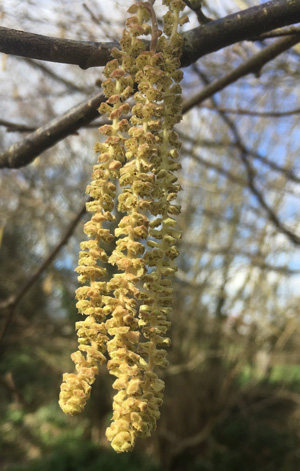
I should not forget the hazel that is in flower
everywhere: the catkins that we see are clusters of male flowers, the
female catkins are much smaller and not as obvious. |
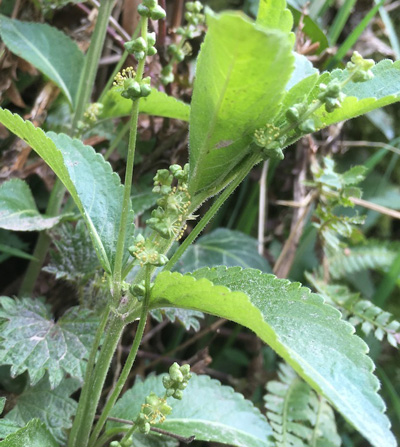
Something that is also not obvious to most people, but common as muck in
most of our hedgerows, is Dog’s mercury. It is in flower right now with
tiny greenish flowers, it produces a horrible smell when crushed, and it
is pretty poisonous, too - hence its older name, Boggart posy.
|
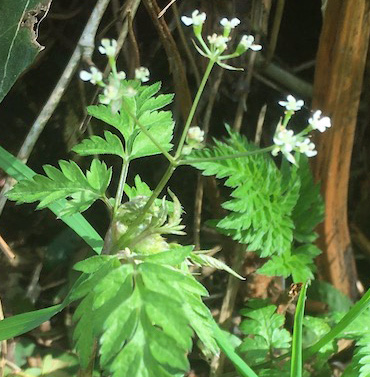
Cow parsley is of course also very common, and later
will fill many roadsides; at the moment it is still unfurling its
leaves, and is still less than a foot high, but some of them already
have some tiny flowers among their young leaves.
|
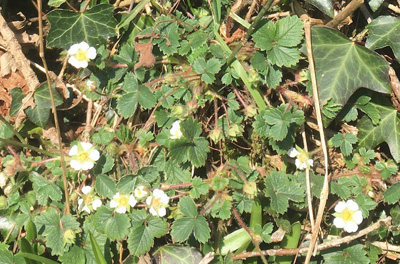
Other ‘earlies’ are Wild strawberries, of which a
few are already coming in flower, such as near Hollowells; and Field
speedwell with its blue flowers in a field near Schoolhouse. I have even
seen my first Stitchwort in flower on Cow Down Lane, on the 9th
of March, much earlier than it should. |
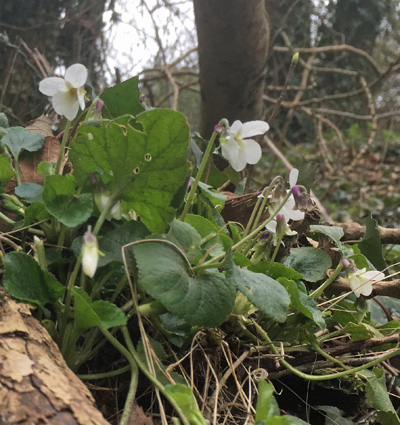
I will end with a hidden gem. Wood violet
(or Sweet
violet) is rare, and not easy to find as it is a very low plant; but if
you spot the flowers you are in for a treat, as they smell very sweet.
Winsham and Thorncombe ones seem to be white, which is a much rarer form
than the usual blue-violet or purple.
|
Some plant facts:
·
the name Dandelion comes from
the French ‘dents de lion’, lion’s teeth, and the leaf margins do look
like wicked teeth.
·
if Hart’s tongue fern is, as
they say, an indicator of ancient woodland, then the whole of Winsham
must have been covered in ancient woodland! And it was, mostly by
Small-leaved lime trees – two thousand years ago.
·
Celandine provides nectar for
emerging bees and other insects at a time when not much else is in
flower.
·
Ramsons are allied to onions
and garlic, and the leaves certainly smell like it! In late spring there
are fantastic stands of it along the ravine-like roads leading up to
Dinnington.
·
There is a story you can only
smell Wood violets once, as they steal your sense of smell… this has a
grain of truth in it, as they contain a chemical that switches off your
smell receptors briefly.
|
| Plants along Winsham
lanes-early April 2021 |
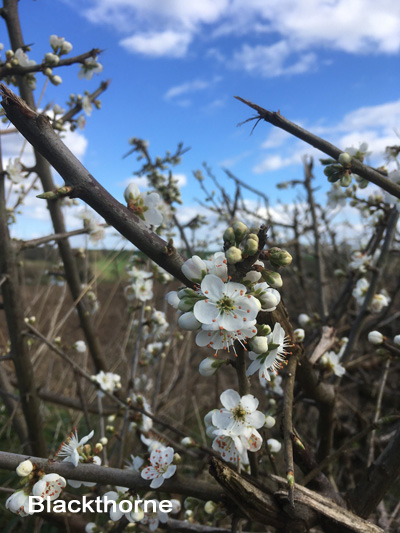 |
It
is definitely looking more lush than a month ago! Our hedgerows
are flushing with leaf buds for Hawthorn, Sycamore, Elder,
Privet and Hazel; and Blackthorn, which flowers before it gets
leaves, gives us white frothy drifts. Through these shrubs the
climbers are also coming into leaf: Bramble, Dog rose, Honey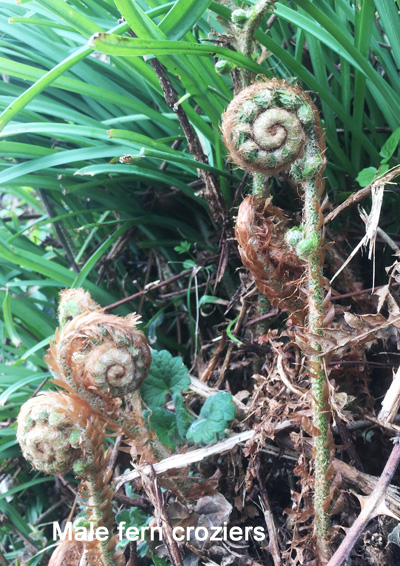 suckle.
But it is in the road and lane verges that the lushness is
happening: the leaves of grasses, hogweed, cleavers, nettles are
shooting up with bewildering speed. Cow parsley goes as fast as
any of these and more of them are coming into flower, but we are
still long before the peak, when they will form almost
continuous stand suckle.
But it is in the road and lane verges that the lushness is
happening: the leaves of grasses, hogweed, cleavers, nettles are
shooting up with bewildering speed. Cow parsley goes as fast as
any of these and more of them are coming into flower, but we are
still long before the peak, when they will form almost
continuous standrscomp.jpg) s
along some lanes! I have seen one or two Lords and ladies in
flower, as well, but these are also before their prime, I think
they are even more common this year than usual. Some other
‘early’ flower sightings are Campion, Vetch, Ramsons and
Jack-by-the-hedge (I wish I knew some proper Somerset names for
these! I am using the names as they appear in Stace’s New flora
of the British Isles); Bluebells are also coming on well, with
individuals in flower here and there; but well before the
glorious peak. The first Bracken spears are coming up, with the
other ferns such as Tongue fern and Male fern already fully more
developed – except here they have been mown, when these are also
sending out their young ‘croziers’, like bishop staffs. s
along some lanes! I have seen one or two Lords and ladies in
flower, as well, but these are also before their prime, I think
they are even more common this year than usual. Some other
‘early’ flower sightings are Campion, Vetch, Ramsons and
Jack-by-the-hedge (I wish I knew some proper Somerset names for
these! I am using the names as they appear in Stace’s New flora
of the British Isles); Bluebells are also coming on well, with
individuals in flower here and there; but well before the
glorious peak. The first Bracken spears are coming up, with the
other ferns such as Tongue fern and Male fern already fully more
developed – except here they have been mown, when these are also
sending out their young ‘croziers’, like bishop staffs.
Last month I sent in my report on early March
plants on the 9th; the day after I saw my first stand
of flowering Wood anemones along Leigh Lane. There are now many
more stands of them,
like on the Chalkway, enjoy them while you can! Butterbur is
another plant that likes to appear in stands, rather than as
scattered individuals, but in this case it is because they
spread by rhizomes,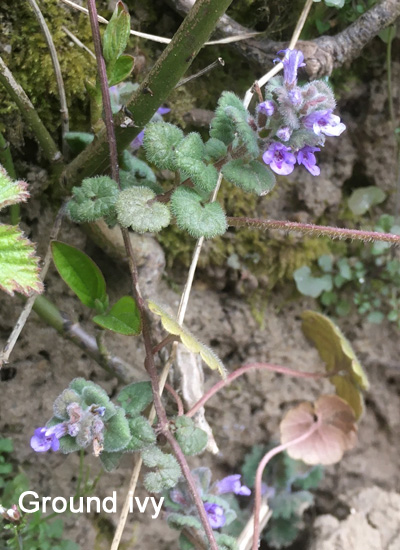 underground root systems. Well into flower are Stitchwort, in
many a roadside; Dandelion and Daisy; Dead nettle and Ground
ivy; and still our lovely Primroses and Wood violets (I saw more
white ones at Sticklepath, but violet ones are now appearing
here and there in Winsham as well), though Celandines are going
over by now. Many a Willow is in flower too, a glorious sight!
underground root systems. Well into flower are Stitchwort, in
many a roadside; Dandelion and Daisy; Dead nettle and Ground
ivy; and still our lovely Primroses and Wood violets (I saw more
white ones at Sticklepath, but violet ones are now appearing
here and there in Winsham as well), though Celandines are going
over by now. Many a Willow is in flower too, a glorious sight!
Here are some plants
that are easily overlooked. Hairy bittercress is tiny, a few
inches at most, but it is very common along fields and probably
in your veg patch, too. And this strange-looking thing is a
young Marsh horsetail, growing in moist sites. It is not quite a
fern, but not too far away from it. These kind o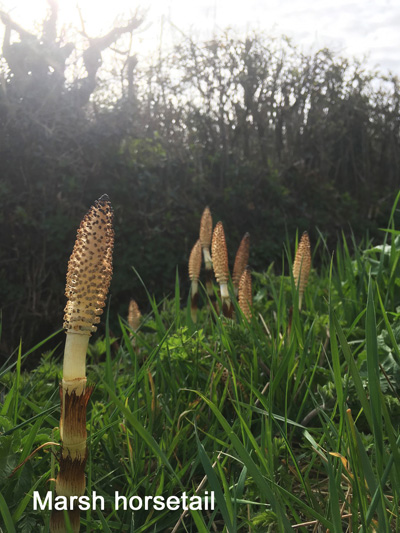 f
plants, the Equisetums,
grew in enormous stands to a hundred feet tall when dinosaurs
roamed the Earth… and just today, the 11tyh of April, I walked
past the brook at Chalkway and saw Golden saxifrage in flower –
tiny (less than an inch) but oh so pretty. f
plants, the Equisetums,
grew in enormous stands to a hundred feet tall when dinosaurs
roamed the Earth… and just today, the 11tyh of April, I walked
past the brook at Chalkway and saw Golden saxifrage in flower –
tiny (less than an inch) but oh so pretty.
And finally, this year the Oak
leaves seem to be well ahead of those of the Ash in development:
Oak before Ash, in for a splash (rather than a soak)?
Some wild plant facts:
·
Hairy
bittercress may be small, but it is very common – and edible,
with a taste between cress and rocket. Raw leaves are good in
salads.
·
Marsh
horsetail has its leaves in whorled branches along the jointed
stem; the pattern of spacing of the nodes, increasingly close
towards the stem top, inspired John Napier to invent logarithms.
This plant is poisonous to grazing animals.
·
The
‘flower’ of Dandelion is really an arrangement of tiny flowers,
between 150 and 200 of them. Daisy ‘flowers’ are built in the
same way: there are 15-30 white flowers along the edge, the
rays; and the yellow middle is composed of hundreds of minute
‘disc’ florets, arranged in a Fibonacci whorl. Aren’t plants
mathematical?
·
Blackthorn,
now in full flower, later produces inky dark fruits: sloes. We
have some nice sloe gin maturing! It has long been associated
with witchcraft (blackthorn, not our sloe gin) and witches’
wands were said to be made out of the wood – as are excellent
walking sticks.
·
You can eat
hawthorn buds – they have a nice nutty flavour!
|
|
|
Wild plants along Winsham lanes –
mid-May 2021
|
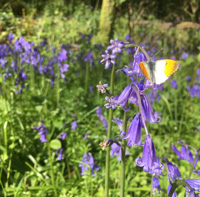 |
It is the 13th
of May when I am writing this and the rain is coming down steadily.
After almost four weeks without rain it finally started on the 8th,
and the plants love it.
The hedges are getting leafier by the day: bright
green for Hazel, Hawthorn and Blackthorn, reddish for Field maple.
Brambles, Nettles and Bracken are shooting up and through but luckily
there are a lot of other May plants as well. Hawthorn is coming into
flower, while Oak has been flowering for a while – just not very visibly
as its flowers (among the young leaves) are tiny and yellowish, the
males hanging down in catkins, the females separate in small groups and
more upright.
But it is the herbs that stand out most at this season
– Winsham is lucky that our hedges are like small linear woodlands, and
some of these hedges are full of colour. There is the blue of Bluebells
(along Cow Down Road or upper Limekiln Lane, for instance), and of the
much smaller Speedwell; the yellow of Yellow archangel; the white of Cow
parsley, Stitchwort and Jack-by-the-hedge and, here and there, patches
of Ramsons (such as N of Whatley, and SW of Purtington); the purple of
Bush vetch and Ground ivy; the pink of Campion and Shining cranesbill.
And so many shades of green! Dark green for Holly, Nettles, the upcoming
Hogweed and Ivy, bright green for many grasses, young Dock, Cranesbill
and Jack-by-the-hedge, and the curious yellow-green of the
Lords-and-ladies. This last one’s leaves were everywhere a month ago,
and now they have almost all gone, to be replaced by a pale hood
shielding the reddish flowering stalk.
Many Dandelions have gone into
fruit, and I have seen whole fields topped by Dandelion clocks; not
something farmers like to see. In moist grassy fields there are stands
of the lovely Cuckooflower,
also called Lady’s smock – hard to believe
this is a close relative of Hairy bittercress!
Some
wild plant facts:
·
it
is a good time if you are keen on garlic. Ramsons, of course, are also
known as Wild garlic, and a leaf or two in your cheese sandwich spices
it up nicely. But Jack-by-the-hedge, also known as Garlic mustard, can
do the same, though their leaves are best before the plant flowers. The
Orangetip butterfly lays its eggs on the youngest leaves just underneath
the flowers.
·
Lords-and-Ladies or Cuckoo-pint has a strange flowering structure.
Hidden within that pale yellow-green hood is a stalk on which the
flowers stand:
females at the base, males above them, and above
the males a ring of hairs that form an insect trap. The flowering stalk
warms up and releases a vile smell, which attracts tiny insects that get
trapped in the hairs: their only escape is through the flowers, where
they get dusted with pollen before they can escape, to fly to the next
trap and pollinate their host!
·
Our
Bluebells are a sign of ancient woodland, and we must have had plenty of
it! They provide nectar for a range of insects. Bluebell woods have a
tradition in folklore of being linked to fairy magic: they were rung to
call the fairies to a gathering, but hearing such a ring would bring
very bad luck to humans. Whatever the truth of that – Bluebell woods are
enchanting!
|
|
Along Winsham lanes, notes on wild plants and
animals by Henk Beentje-
Midsummer-June 2021
I am writing this on June 20th , one day
before Midsummer, and it shows. The differences with my May rambles are
amazing: the hedgerows are now completely leafy, the lane verges have
exploded in height, and in width too, and as a result narrow lanes are
now looking even narrower! Cow parsley dominated the verges for a while,
turning them white and lacy, but has now gone over; its relative,
Hogweed, is everywhere but not
as continuous as Cow parsley was. It is taller, though, and at its basal
leaves are huge. The main colour of the verges has turned to green, with
many more ‘weedy’ plants making their way upwards: Bracken
has gone from nil to 60 mph in a minute,
Stinging nettles, Bindweed, Goos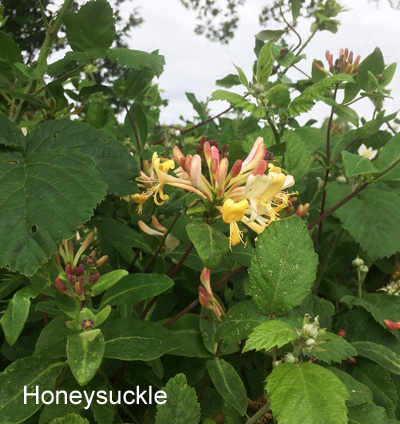 egrass
or Cleavers,
Sorrel… and grasses. High grass, lush grass, it is
everywhere and the farmers are getting in the hay as fast as they can.
As there are about 160 different species of grass in the UK I have
always found them rather difficult to keep apart, but luckily in our
area there are only two that are (at least at the moment) really common
in roadsides: False oat
grass, with rather feathery heads, and
Cock’s foot with more clumpy heads. These are the
tall ones that are just about everywhere, with Yorkshire fog
(softly hairy) and Perennial rye grass (lower,
much less noticeable with its appressed heads) less common; and only in
one site, Whatley Lane near the turnoff to Leigh Lane, have I spotted
Wood melick, a grass that is an indicator of
ancient woodland. egrass
or Cleavers,
Sorrel… and grasses. High grass, lush grass, it is
everywhere and the farmers are getting in the hay as fast as they can.
As there are about 160 different species of grass in the UK I have
always found them rather difficult to keep apart, but luckily in our
area there are only two that are (at least at the moment) really common
in roadsides: False oat
grass, with rather feathery heads, and
Cock’s foot with more clumpy heads. These are the
tall ones that are just about everywhere, with Yorkshire fog
(softly hairy) and Perennial rye grass (lower,
much less noticeable with its appressed heads) less common; and only in
one site, Whatley Lane near the turnoff to Leigh Lane, have I spotted
Wood melick, a grass that is an indicator of
ancient woodland.
Of course there is colour, here and there, with the
yellow of Buttercups, Herb bennet and Wild lettuce
common, the pink of Campions, Clover and Herb Robert – and
Foxgloves, towering above all the rest. In the hedges
Hawthorn and Elder are doing their bit,
Dog roses
have just begun to flower, as have Brambles,
and Honeysuckle
is providing several colours all on its own - as well as evening scent
for the pollinating insects that are so busy at this time.
Bees, Bumblebees, Hoverflies are at it, but I have found
Butterflies less common than last year. Orangetips
are few by now, and there is the occasional Admiral
or Brimstone. There have been a few
Damselflies about, but not many, and I have
not spotted any Dragonflies yet, though Juliet
did; Wasps are about (hopefully feasting on
aphids), and Hornets too. Birdsong peaked in
May, and by now is down to a minimum; they are probably too busy feeding
their young! I did hear a Tawny owl calling
from Channing’s Coppice, and recently saw a Kestrel
by Whatley; Martins and Swallows are swooping
about, and in general early Summer is well established at Winsham.
I will end with some less common plants you may
have spotted: Pennywort is now in flower on steep
banks, Greater celandine (no relative to the
small celandine of early spring) on or by
walls, and Hedge
woundwort… by hedges.
Some wild plant facts:
Foxglove
provides digitalis, an important drug used in heart conditions.
Sorrel has a
distinctive acid taste, and the acid juice from the plant was used in
olden days to remove stains from laundry.
Elder
leaves were once used to keep flies away, and branches were hung in
dairies.
|
Editors Note: As Liz Earl is leaving the
village-not moving too far, so we all hope to continue to see a lot of
her- Henk has volunteered to add local fauna to his monthly notes about
his walks. I am also hoping to persuade him to edit these notes into the
Annual Nature Diary that Liz has been producing over the last six
years or so for Winsham Web Museum. |
Walking Winsham Lanes-12th July 2021
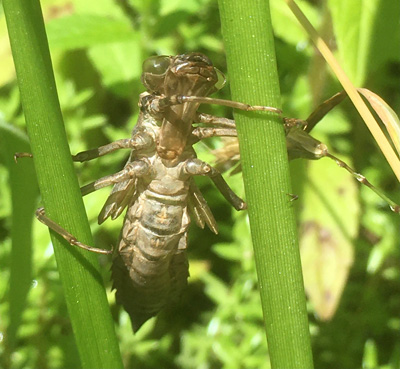 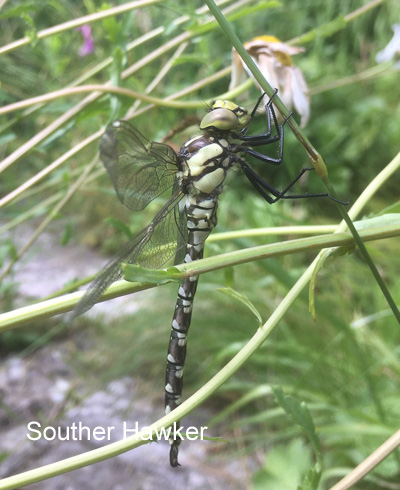
By the pond!
My main impression this month
on walking Winsham Lanes is green, lush and high. All that rain!! Many
shades of green (which reminds me of the Small faces’ Itchy coo Park,
showing my age) with on first impression only a few touches of white:
Elderflower,
Hogweed and
Bramble mostly, Meadowsweet
coming in very recently; with here and there some
Bindweed, and in more open places
Oxe-eye daisy,
Chamomile and Yarrow.
In woods Enchanted nightshade
is now in flower. The occasional purple comes in more concentrated
patches, mainly from Foxgloves,
in open sites Rosebay
Willowherb, a few more
Campions, and very occasionally some patches of
Mallow. Yellow seems to be
getting rare, the odd Buttercup
(I am talking Winsham lanes, not my lawn!!) or
Dandelion - which is just as often
Hawksbit, looking like
Dandelion but with branching stems; and
Meadow vetchling,
Wild lettuce.
And, coming to a place near you, Thistles. Lots of
Thistles. They come in various sizes and shapes, but they all like soils
rich in nutrients and they are all prickly – from rather prickly (like
the yellow Prickly sow thistle)
to quite (Meadow thistle) to
very very (like the Spear
thistle).
If you are wondering what the very large leaves are
that come in substantial stands, such as on Whatley Cross, or Leigh
Lane: these are Butterbur,
which flowered much earlier in the year. The name comes from one of the
former uses: butter used to be packed in these leaves, which can be up
to three feet across!
With all this rain, there are
even mushrooms coming out: in the grass I have spotted
Meadow puffball and
Pleated inkcap in small
numbers. Good for mushrooms, that rain, not so good for butterflies;
while there are a lot of
Gatekeepers about, in general butterfly numbers are pretty low for
this time of year, and diversity is not high either.
All I have
seen recently are those gatekeepers, a few
Admiral, the odd
Speckled wood and a few
Small tortoiseshell; plus
quite a few moths, but I am not good at those and all I can name is the
Cinnabar I saw last week – oh,
and the caterpillar of the Mullein
moth is all over our garden Mulleins. Slightly better on the dragon-
and damselfly front: Southern
hawkers, Large red
damselfly, Variable damselfly
and Common blue damselfly,
plus the odd Beautiful demoiselle
– very pretty, those. Still, on sunny evenings I can see lots of insects
flying about, and certainly our
Swallows and Martins are
having a good time! And so do the slugs and snails – I took a picture of
one that I later identified as the
White-lipped
snail, quite common, and said to subsist on a diet of nettles,
hogweed and ragwort.
I also spotted the first
Himalayan balsam
in flower – a nasty invasive weed, which takes over riverbanks and other
moist places if not held in check; and then, in winter, there is nothing
to hold the soil together (its root system is pathetic) and erosion
follows. Rip it out where you see it!
A few wild plant
facts:
●
Rosebay willowherb is a
real pioneer in open spaces. It has been used in cordage, in
fire-lighting, and cuts can be treated by putting a piece of cut stem on
the area.
●
Yarrow is used in
wound-healing, but in olden days it was also a charm against bad luck
and illness.
●
Chamomile is of course
used to make tea, from fresh or dried flower heads.
●
Ox-eye daisy central
flowers form an intricate and beautiful Fibonacci spiral!
|
| |
|
|
|








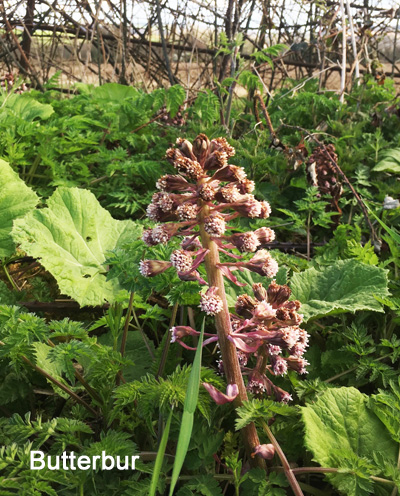
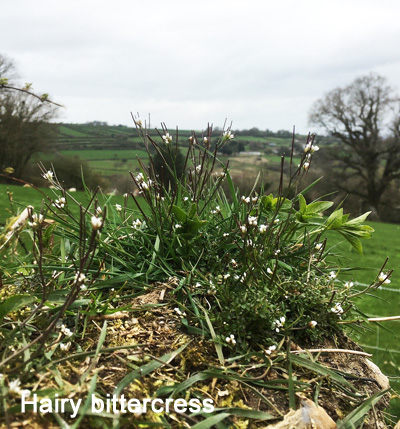
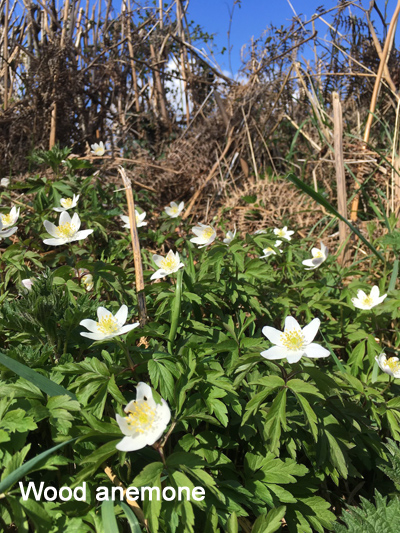
 suckle.
But it is in the road and lane verges that the lushness is
happening: the leaves of grasses, hogweed, cleavers, nettles are
shooting up with bewildering speed. Cow parsley goes as fast as
any of these and more of them are coming into flower, but we are
still long before the peak, when they will form almost
continuous stand
suckle.
But it is in the road and lane verges that the lushness is
happening: the leaves of grasses, hogweed, cleavers, nettles are
shooting up with bewildering speed. Cow parsley goes as fast as
any of these and more of them are coming into flower, but we are
still long before the peak, when they will form almost
continuous standrscomp.jpg) s
along some lanes! I have seen one or two Lords and ladies in
flower, as well, but these are also before their prime, I think
they are even more common this year than usual. Some other
‘early’ flower sightings are Campion, Vetch, Ramsons and
Jack-by-the-hedge (I wish I knew some proper Somerset names for
these! I am using the names as they appear in Stace’s New flora
of the British Isles); Bluebells are also coming on well, with
individuals in flower here and there; but well before the
glorious peak. The first Bracken spears are coming up, with the
other ferns such as Tongue fern and Male fern already fully more
developed – except here they have been mown, when these are also
sending out their young ‘croziers’, like bishop staffs.
s
along some lanes! I have seen one or two Lords and ladies in
flower, as well, but these are also before their prime, I think
they are even more common this year than usual. Some other
‘early’ flower sightings are Campion, Vetch, Ramsons and
Jack-by-the-hedge (I wish I knew some proper Somerset names for
these! I am using the names as they appear in Stace’s New flora
of the British Isles); Bluebells are also coming on well, with
individuals in flower here and there; but well before the
glorious peak. The first Bracken spears are coming up, with the
other ferns such as Tongue fern and Male fern already fully more
developed – except here they have been mown, when these are also
sending out their young ‘croziers’, like bishop staffs.  underground root systems. Well into flower are Stitchwort, in
many a roadside; Dandelion and Daisy; Dead nettle and Ground
ivy; and still our lovely Primroses and Wood violets (I saw more
white ones at Sticklepath, but violet ones are now appearing
here and there in Winsham as well), though Celandines are going
over by now. Many a Willow is in flower too, a glorious sight!
underground root systems. Well into flower are Stitchwort, in
many a roadside; Dandelion and Daisy; Dead nettle and Ground
ivy; and still our lovely Primroses and Wood violets (I saw more
white ones at Sticklepath, but violet ones are now appearing
here and there in Winsham as well), though Celandines are going
over by now. Many a Willow is in flower too, a glorious sight! f
plants, the Equisetums,
grew in enormous stands to a hundred feet tall when dinosaurs
roamed the Earth… and just today, the 11tyh of April, I walked
past the brook at Chalkway and saw Golden saxifrage in flower –
tiny (less than an inch) but oh so pretty.
f
plants, the Equisetums,
grew in enormous stands to a hundred feet tall when dinosaurs
roamed the Earth… and just today, the 11tyh of April, I walked
past the brook at Chalkway and saw Golden saxifrage in flower –
tiny (less than an inch) but oh so pretty.
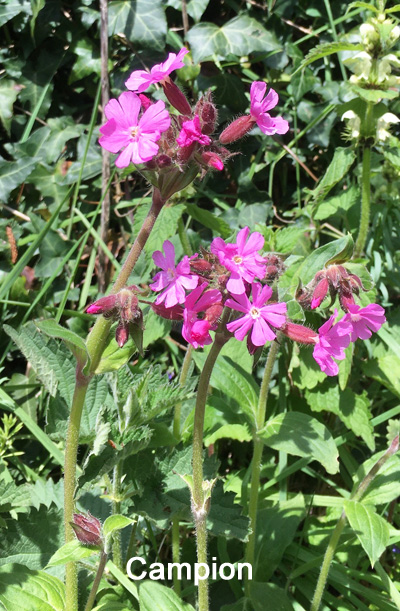
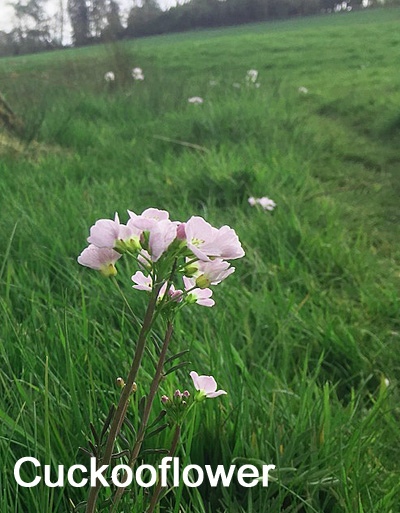
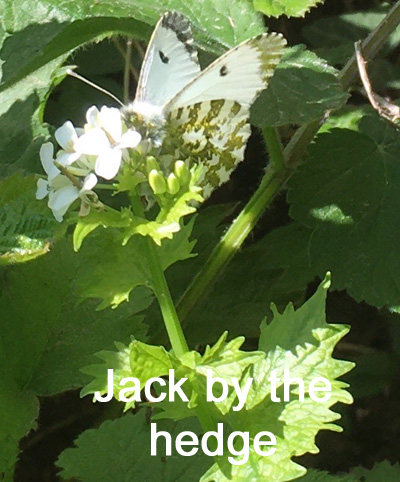
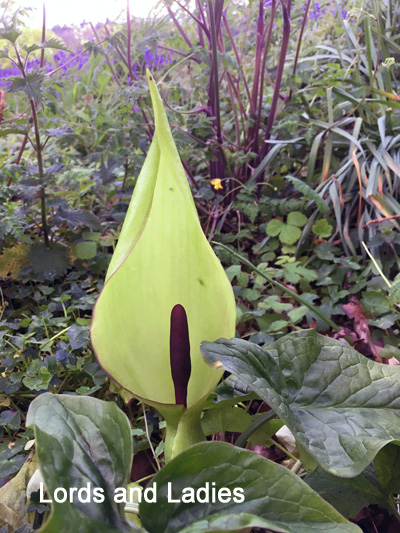
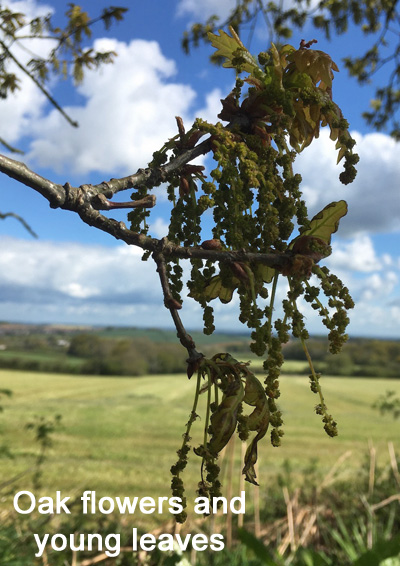
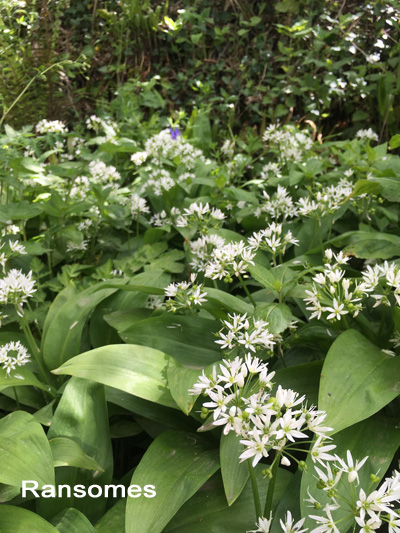
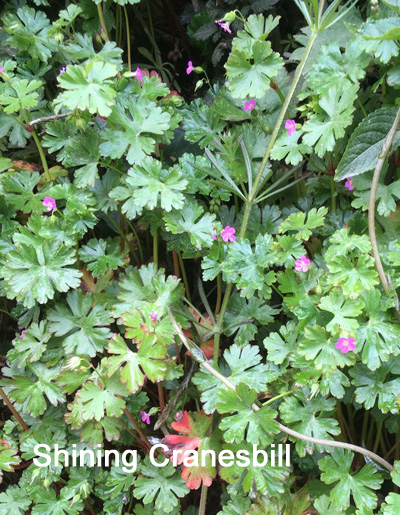
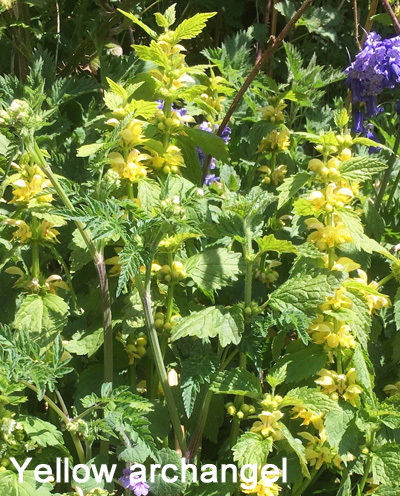
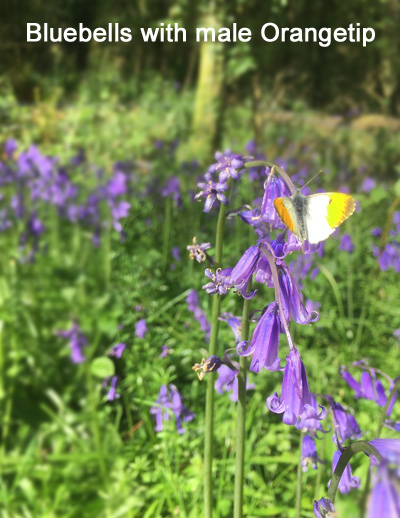
 egrass
or Cleavers,
Sorrel… and grasses. High grass, lush grass, it is
everywhere and the farmers are getting in the hay as fast as they can.
As there are about 160 different species of grass in the UK I have
always found them rather difficult to keep apart, but luckily in our
area there are only two that are (at least at the moment) really common
in roadsides: False oat
grass, with rather feathery heads, and
Cock’s foot with more clumpy heads. These are the
tall ones that are just about everywhere, with Yorkshire fog
(softly hairy) and Perennial rye grass (lower,
much less noticeable with its appressed heads) less common; and only in
one site, Whatley Lane near the turnoff to Leigh Lane, have I spotted
Wood melick, a grass that is an indicator of
ancient woodland.
egrass
or Cleavers,
Sorrel… and grasses. High grass, lush grass, it is
everywhere and the farmers are getting in the hay as fast as they can.
As there are about 160 different species of grass in the UK I have
always found them rather difficult to keep apart, but luckily in our
area there are only two that are (at least at the moment) really common
in roadsides: False oat
grass, with rather feathery heads, and
Cock’s foot with more clumpy heads. These are the
tall ones that are just about everywhere, with Yorkshire fog
(softly hairy) and Perennial rye grass (lower,
much less noticeable with its appressed heads) less common; and only in
one site, Whatley Lane near the turnoff to Leigh Lane, have I spotted
Wood melick, a grass that is an indicator of
ancient woodland. 